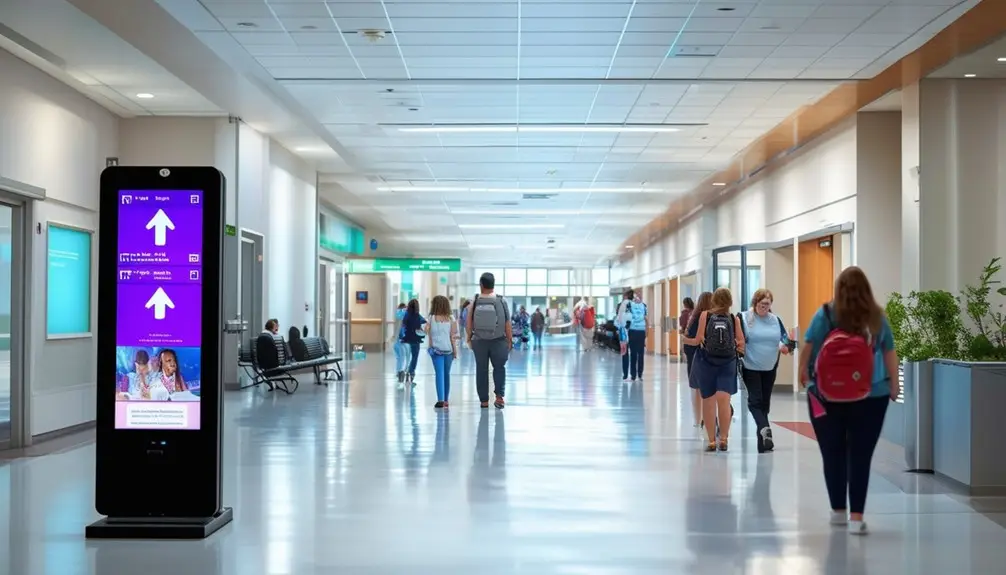You’ll notice that digital wayfinding systems in large hospitals significantly enhance navigation by providing real-time, step-by-step guidance and interactive maps. These systems utilize GPS, Wi-Fi, and Bluetooth beacons for accurate, indoor location tracking. Patients and visitors benefit from reduced confusion and increased efficiency, while multilingual support guarantees accessibility for all. Hospital staff experience operational efficiencies as the need for personal assistance decreases. Effective deployment relies on collaboration between facilities management, IT, and administrative teams. The integration of mobile apps and QR codes also improves the user experience, minimizing frustration associated with outdated signage. Want to discover more details?
Key Takeaways
- Digital wayfinding systems provide real-time navigation and interactive maps to enhance patient experience in large hospitals.
- Mobile apps with GPS, Wi-Fi, and BLE offer precise, step-by-step directions within complex hospital layouts.
- Interactive kiosks deliver turn-by-turn guidance and detailed facility maps for efficient navigation.
- QR codes enable quick access to navigation aids and real-time updates through smartphone scanning.
- Multi-lingual support in digital wayfinding systems ensures ease of navigation for non-native speakers.
Benefits of Digital Wayfinding
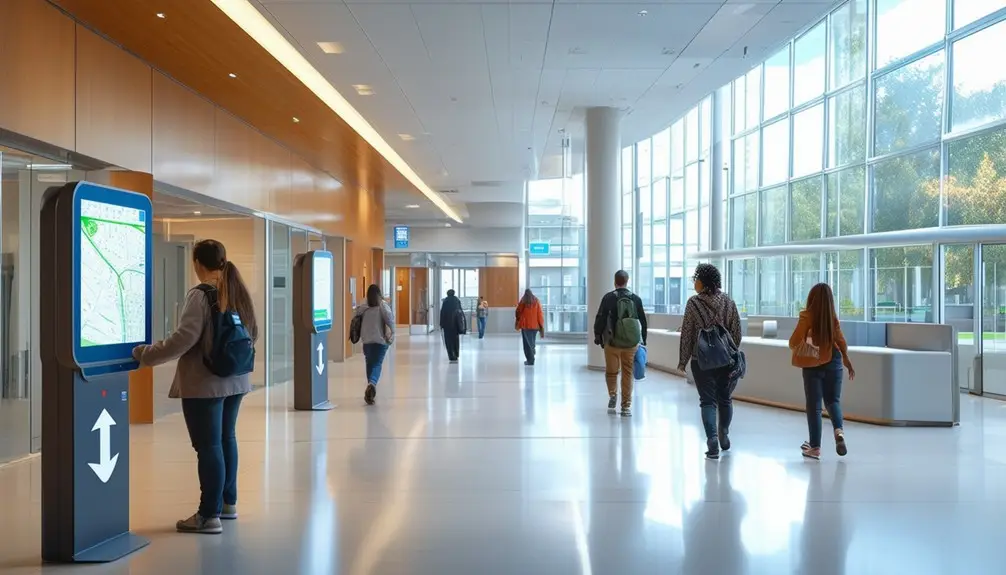
Digital wayfinding systems in large hospitals greatly improve patient experience by reducing stress and confusion through real-time directions and information. These systems provide patients with interactive maps and turn-by-turn guidance, notably enhancing navigation within the hospital campus. You’ll notice that the integration of real-time information guarantees patients can find their way efficiently, minimizing the chances of getting lost or being late for appointments.
Implementing digital wayfinding systems enhances operational efficiency for hospital staff as well. With fewer patients needing personal assistance to locate departments or services, staff can focus on more critical tasks. Furthermore, these systems offer multi-lingual support, ensuring non-native speakers can navigate the hospital campus with ease, further enhancing the overall patient experience.
Advanced technologies like Bluetooth, GPS, and augmented reality (AR) are integrated into these systems to provide seamless navigation and precise guidance. Real-time updates and highlighted routes guarantee patients are continuously informed and on the correct path. This not only reduces the likelihood of missed appointments but also enhances user satisfaction by providing a smooth, stress-free experience. By leveraging digital wayfinding systems, hospitals can notably improve patient flow and satisfaction, making the overall healthcare experience more efficient and pleasant.
Identifying Ineffective Solutions
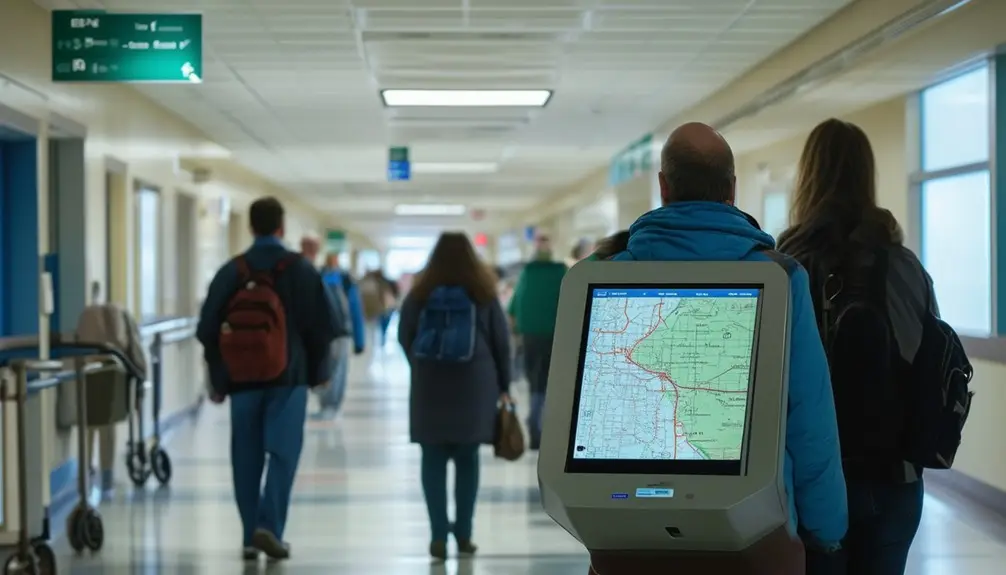
To identify ineffective wayfinding solutions, you should monitor indicators of visitor confusion, such as high volumes of direction inquiries and user feedback. Outdated or inaccurate signage can exacerbate these issues, leading to operational inefficiencies. Analyzing these factors provides evidence-based insights into the system’s shortcomings.
Visitor Confusion Indicators
Visitor confusion in large hospitals often stems from outdated or poorly visible signage, leading to frequent requests for directions and evident frustration. High volumes of inquiries for directions directly indicate ineffective wayfinding solutions. When visitors can’t easily navigate the hospital, you’ll notice increased visitor frustration and confusion, which are clear indicators of an ineffective system.
A primary contributor to disorientation is the lack of visibility in signage and displays. Poor lighting, small fonts, and inadequate placement of signs can exacerbate the issue. Additionally, outdated or inaccurate information in wayfinding materials further complicates navigation, causing visitors to feel lost and overwhelmed.
User feedback is essential for identifying these ineffective wayfinding solutions. When visitors report difficulties, it provides actionable insights into specific problem areas. For example, if multiple users mention trouble finding a particular department, it’s a strong indication that the current signage or digital navigation tools are insufficient.
Outdated Signage Issues
Identifying ineffective wayfinding solutions often starts with recognizing outdated signage, which hampers navigation to a great extent and elevates visitor frustration in large hospitals. When you rely on old or poorly maintained signage, it becomes evident through increased confusion and complaints. These issues necessitate a shift towards modern digital wayfinding solutions.
Outdated signage often fails due to the following:
- Lack of Visibility: Signs that aren’t easily seen cause missed turns and prolonged searches.
- Inaccurate Information: Incorrect or old data leads to misunderstandings about current hospital layouts.
- Poor Design: Badly designed signs with small fonts or unclear symbols aren’t user-friendly.
- Absence of Feedback Integration: Ignoring user feedback means persistent flaws aren’t addressed.
User feedback is essential for identifying these shortcomings. Patients and visitors can report their difficulties, providing valuable insights into the inefficacy of current signage solutions. Regularly conducted system functionality assessments help in pinpointing and rectifying these issues.
In large hospitals, digital wayfinding solutions offer a robust alternative. They provide real-time updates and interactive maps, greatly enhancing the user experience. By addressing the limitations of outdated signage, hospitals can reduce visitor frustration and improve overall navigation efficiency.
Direction Inquiries Volume
A high volume of direction inquiries from visitors often signals the inadequacy of the hospital’s wayfinding systems. When digital hospital wayfinding systems fail to provide clear and accurate navigation, the direction inquiries volume inevitably increases. This influx not only strains the hospital staff but also contributes to significant visitor frustration, negatively impacting the overall patient experience.
Ineffective wayfinding systems frequently stem from poor signage and display visibility, leading visitors to miss essential directional cues. Outdated or inaccurate information exacerbates this issue, causing confusion and inefficiency. When signage is not updated to reflect current layouts or temporary changes, visitors may find themselves lost, further increasing the need for direction inquiries.
Digital hospital wayfinding can alleviate these problems by offering real-time updates and intuitive navigation. If these systems are not user-friendly or fail to integrate seamlessly with physical signage, they can still fall short. The key to reducing direction inquiries volume lies in ensuring that digital wayfinding solutions are both thorough and accessible. Regular audits and updates to both digital and physical wayfinding elements are essential to maintaining their effectiveness and minimizing visitor frustration.
Implementation Team Roles
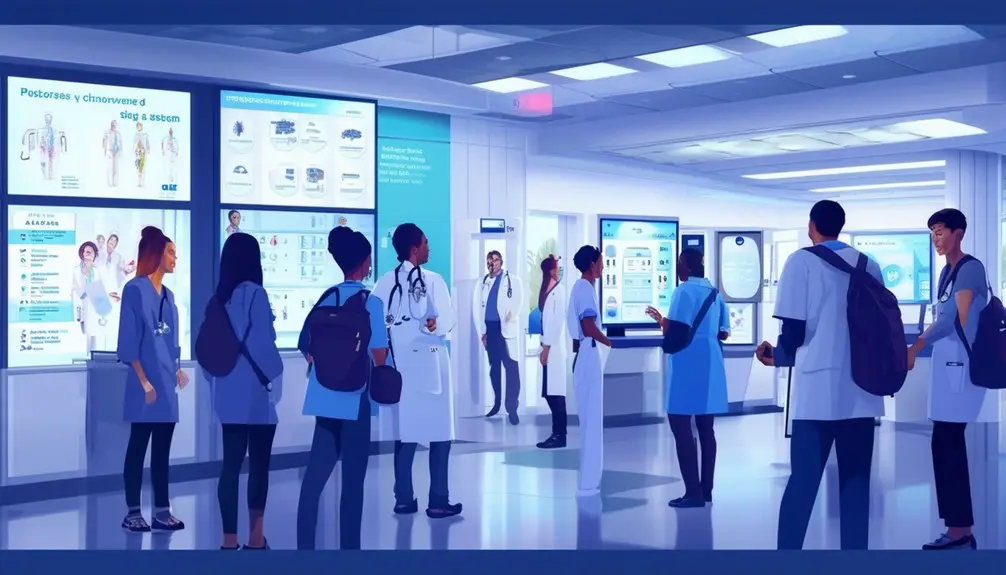
Effective implementation of digital wayfinding systems in large hospitals relies on the collaborative efforts of diverse teams, each bringing specialized expertise to the table. The success of digital wayfinding signage and interactive kiosks depends heavily on the seamless integration of various departments, ensuring a cohesive and user-friendly patient experience.
- Facilities Management: This team is responsible for the physical installation of digital wayfinding solutions, placing signage and kiosks optimally for maximum visibility and accessibility.
- Information Technology (IT): IT teams handle the technical aspects, including the development and maintenance of digital solutions like interactive kiosks and mobile applications. They ensure these systems are reliable, secure, and user-friendly.
- Hospital Administration: Administration oversees the funding and strategic alignment of wayfinding projects. They guarantee that resources are adequately allocated and that the project aligns with the hospital’s broader goals and budget constraints.
- Marketing and Communications: This team manages promotional activities and designs the user interface to optimize engagement. They play a pivotal role in communicating the availability and benefits of the wayfinding systems to both patients and staff.
Each of these roles is essential for the effective deployment of a digital wayfinding system that enhances patient experience and operational efficiency.
Key Technologies
In large hospitals, digital wayfinding systems leverage interactive kiosks, mobile apps, and QR codes to enhance navigation. You’ll find interactive kiosks offering detailed maps and turn-by-turn guidance, while mobile apps provide real-time updates and multi-lingual support. QR codes simplify the process by enabling instant access to navigation aids with a quick scan.
Interactive Kiosks Features
How do interactive kiosks harness advanced technologies like Bluetooth Low Energy (BLE), Wi-Fi, and GPS to provide accurate location tracking and seamless navigation in large hospital environments? Digital wayfinding kiosks utilize these technologies to deliver precise, interactive navigation solutions. BLE and Wi-Fi enable real-time positioning, ensuring users receive accurate step-by-step directions. GPS integration further enhances this, allowing for smooth indoor-outdoor shifts.
Key features include:
- Step-by-step directions: Interactive kiosks provide detailed guidance, significantly reducing the likelihood of getting lost.
- Dynamic updates: These kiosks offer real-time information, adjusting for changes in the environment, such as closed corridors or relocated departments.
- Facility maps: Users can access detailed, interactive facility layouts, helping them visualize their path and destination.
- Destination search: Users can input specific destinations or search for locations, making navigation more streamlined.
Mobile App Navigation
Mobile app direction in large hospitals utilizes GPS, Wi-Fi, and Bluetooth Low Energy (BLE) technologies to provide precise, real-time guidance for both indoor and outdoor environments. By combining these location services, the apps offer a seamless direction experience, providing step-by-step directions and interactive indoor maps that are essential in complex hospital layouts.
Bluetooth beacons play an important role in indoor direction by enabling precise location tracking and proximity-based notifications. When integrated with mobile app direction, these beacons facilitate accurate real-time updates, ensuring you always know where you are and how to reach your destination. This level of precision is particularly beneficial in multi-level hospital buildings where GPS signals might falter.
Mobile app direction enhances patient experience by offering personalized routes, parking information, and points of interest such as cafeterias and restrooms. These features not only streamline your journey but also greatly reduce stress associated with finding your way in unfamiliar environments. Hospitals that implement these advanced technologies can improve operational efficiency and overall patient satisfaction. By adopting user-friendly direction features, hospitals guarantee visitors and patients enjoy a smoother, more efficient wayfinding experience, ultimately contributing to higher levels of satisfaction and reduced anxiety.
QR Code Utilization
Leveraging QR codes in hospital wayfinding offers an efficient, cost-saving solution for delivering location-specific directions and important information to patients and visitors. By scanning a QR code with their smartphones, users can instantly access maps, directions, and other essential navigation details without the need for additional hardware installations. This technology notably enhances the user experience in large hospitals.
QR codes streamline navigation by providing immediate access to digital displays that guide users through complex hospital layouts. Here are four key benefits:
- Accessibility: QR codes are easily scanned using smartphones, making them accessible to a wide range of users, including those who may not be tech-savvy.
- Cost-Effectiveness: Implementing QR codes eliminates the need for costly hardware, such as kiosks or digital signage, reducing overall expenses.
- Efficiency: QR code signage reduces confusion and enhances wayfinding efficiency, allowing patients and visitors to navigate the hospital with ease.
- Real-Time Updates: Hospitals can quickly update the information linked to QR codes, ensuring that users always receive the most current and precise directions.
Incorporating QR codes into hospital wayfinding systems not only improves navigation but also supports a seamless, efficient, and user-friendly experience.
Factors Impacting Adoption
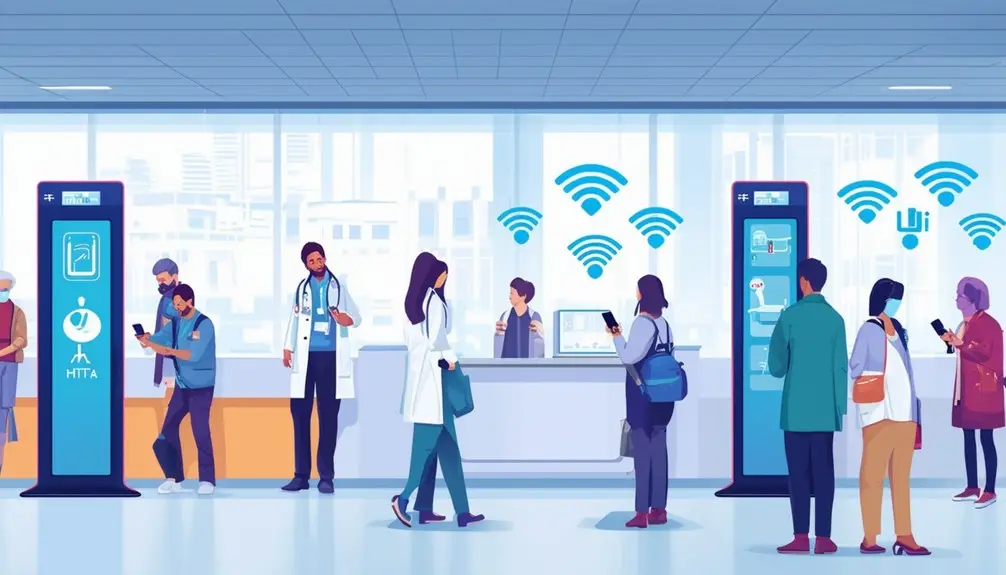
Several key factors directly impact the adoption of digital wayfinding systems in large hospitals, requiring a thorough approach to address language proficiency, accessibility, cultural sensitivity, and education level. Language proficiency is important, as effective digital systems must communicate clearly. Language barriers can greatly hinder user uptake, making multilingual support essential.
Accessibility features are essential. To guarantee compliance with standards and inclusive adoption, digital wayfinding systems need to accommodate users with disabilities. This includes visual, auditory, and mobility impairments, among others.
Cultural factors also play a significant role. Sensitivity in the design of digital systems can cater to diverse cultural preferences and improve adoption rates. Ensuring that the system respects cultural norms and practices is key.
Education level correlates with comfort in using technology. Training programs are necessary to bridge gaps in tech-savviness, ensuring all users, regardless of their educational background, can effectively utilize the system.
Engaging stakeholders during the planning phase is crucial to assess specific needs and tailor the digital wayfinding solution accordingly. By considering the unique characteristics and requirements of the hospital, stakeholders can guarantee the system’s successful implementation and adoption.
Enhancing Patient Experience
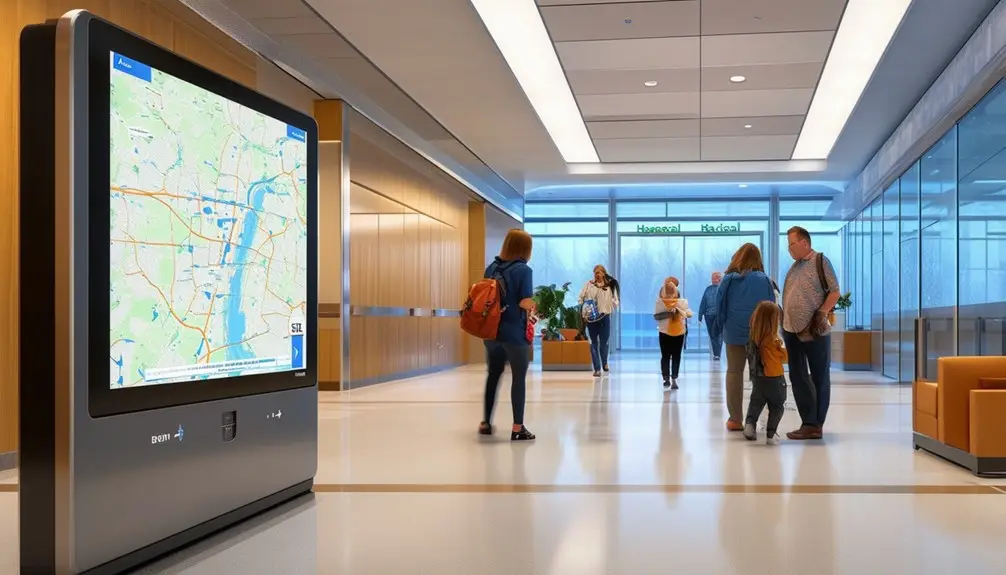
Implementing digital wayfinding systems in large hospitals greatly enhances patient experience by reducing anxiety and providing seamless navigation. These systems integrate real-time navigation, wayfinding signage, and appointment reminders, fundamentally transforming how patients interact with healthcare facilities. By leveraging Google Maps-powered technology, patients can familiarize themselves with the hospital layout before arrival, mitigating stress and confusion.
Key benefits include:
- Real-time navigation: Patients receive precise, up-to-the-minute directions, ensuring they reach their destinations efficiently.
- Appointment reminders: Automated notifications help patients keep track of their schedules, significantly reducing missed appointments.
- Wayfinding signage: Digital displays and interactive maps highlight key points of interest, making it easier for patients to find essential services.
- Location sharing: Securely sharing location information with family or friends enhances safety and communication.
Conclusion
So, you think you can navigate a sprawling hospital maze without digital wayfinding? That’s adorable. In reality, without embracing cutting-edge tech and a cohesive implementation team, you’re just setting yourself up for lost patients and chaos. Sure, outdated paper maps and confusing signs might sound nostalgic, but they won’t enhance patient experience or efficiency. Embrace the future: it’s not just about convenience; it’s about survival in a world where efficiency and patient satisfaction reign supreme.
Frequently Asked Questions
What Is the Digital Signage Software for Hospitals?
Digital signage software for hospitals provides interactive maps, real-time facility updates, and turn-by-turn navigation. It reduces patient stress, boosts operational efficiency, and supports multiple languages, enhancing communication and providing essential information during emergencies.
What Methods Might Be Used to Improve Wayfinding in a Healthcare Facility?
Although you might worry about implementation costs, utilizing mobile apps with turn-by-turn guidance, interactive digital kiosks, digital signage, voice-activated assistants, and augmented reality systems greatly enhances patient navigation, demonstrating a clear return on investment.
What Is Hospital Wayfinding?
Hospital wayfinding encompasses navigation systems guiding patients, visitors, and staff through large hospitals. Effective wayfinding reduces stress, enhances user satisfaction, and guarantees safety by offering precise, timely directions and crucial emergency information, optimizing operational efficiency and traffic flow.
What Is Digital Wayfinding?
Imagine a digital compass guiding you through complex environments. Digital wayfinding uses interactive kiosks and mobile apps, integrating GPS and Bluetooth, to provide precise indoor navigation, enhancing user experience and operational efficiency in large facilities.

